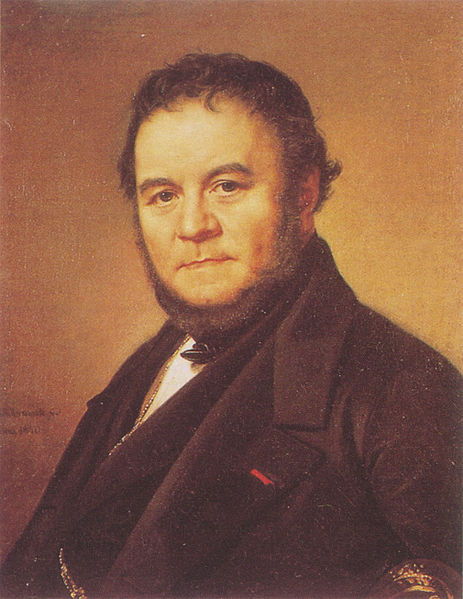<Back to Index>
- Physicist Ernst Karl Abbe, 1840
- Writer Marie Henri Beyle (Stendhal), 1783
- Samurai Saigō Takamori (Takanaga), 1828
PAGE SPONSOR

Marie-Henri Beyle (23 January 1783 – 23 March 1842), better known by his pen name Stendhal, was a 19th century French writer. Known for his acute analysis of his characters' psychology, he is considered one of the earliest and foremost practitioners of realism in his two novels Le Rouge et le Noir (The Red and the Black, 1830) and La Chartreuse de Parme (The Charterhouse of Parma, 1839).
Born in Grenoble, Isère, he had an unhappy childhood in what he found to be stifling provincial France, disliking his "unimaginative" father and mourning his mother, who had died when he was young. His closest friend was his younger sister, Pauline, with whom he maintained a steady correspondence throughout the first decade of the 19th century.
The military and theatrical worlds of the First French Empire were a revelation to Beyle. He was named an auditor with the Conseil d'État on 3 August 1810, and thereafter took part in the French administration and in the Napoleonic wars. He travelled extensively in Germany and was part of Napoleon's army in the 1812 invasion of Russia.
After the 1814 Treaty of Fontainebleau, he left for Italy, where he settled in Milan. He formed a particular attachment to Italy, where he spent much of the remainder of his career, serving as French consul at Trieste and Civitavecchia. His novel The Charterhouse of Parma,
written in 52 days, is set in Italy, which he considered a more sincere
and passionate country than Restoration France. An aside in that novel,
referring to a character who contemplates suicide after being jilted,
speaks volumes about his attitude towards his home country: "To make
this course of action clear to my French readers, I must explain that
in Italy, a country very far away from us, people are still driven to
despair by love." Beyle used the pseudonym "Stendhal" (and over 100 others), and scholars in general believe he borrowed this nom de plume from the German city of Stendal in homage to Johann Joachim Winckelmann. Stendhal
was a dandy and wit about town in Paris, as well as an inveterate
womaniser who was obsessed with his sexual conquests. His genuine
empathy towards women is evident in his books; Simone de Beauvoir spoke highly of him in The Second Sex. He seems to have preferred desire to consummation. One of his early works is On Love, a rational analysis of romantic passion that was based on his unrequited love for Mathilde, Countess Dembowska, whom he met while living at Milan. This fusion of, and tension between, clear-headed analysis and romantic
feeling is typical of Stendhal's great novels; he could be considered a
Romantic realist. Stendhal
suffered miserable physical disabilities in his final years as he
continued to produce some of his best work. As he noted in his journal,
he was taking iodide of potassium and quicksilver to treat his syphilis,
resulting in swollen armpits, difficulty swallowing, pains in his
shrunken testicles, sleeplessness, giddiness, roaring in the ears,
racing pulse and tremors so bad he could scarcely hold a fork or a pen.
Indeed, he dictated Charterhouse in
this pitiable state. Modern medicine has shown that his health problems
were more attributable to his treatment than to his syphilis. Stendhal died on 22 March 1842, a few hours after collapsing with a seizure on the streets of Paris. He is interred in the Cimetière de Montmartre. Contemporary readers did not fully appreciate Stendhal's realistic style during the Romantic period
in which he lived; he was not fully appreciated until the beginning of
the 20th century. He dedicated his writing to "the Happy Few." This is
often interpreted as a dedication to the few who could understand his
writing, or as a sardonic reference to the happy few who are born into
prosperity (the latter interpretation is supported by the likely source
of the quotation, Canto 11 of Byron's Don Juan,
a frequent reference in the novel, which refers to "the thousand happy
few" who enjoy high society), or as a reference to those who lived
without fear or hatred. It may also refer, given Stendhal's experience
of the Napoleonic wars, to the "we few, we happy few, we band of
brothers" line of Shakespeare's Henry V. Today, Stendhal's works attract attention for their irony and psychological and historical dimensions. Stendhal was an avid fan of music, particularly the works of the composers Cimarosa, Mozart and Rossini. He wrote a biography about Rossini, Vie de Rossini (1824), now more valued for its wide ranging musical criticism than for its historical content.